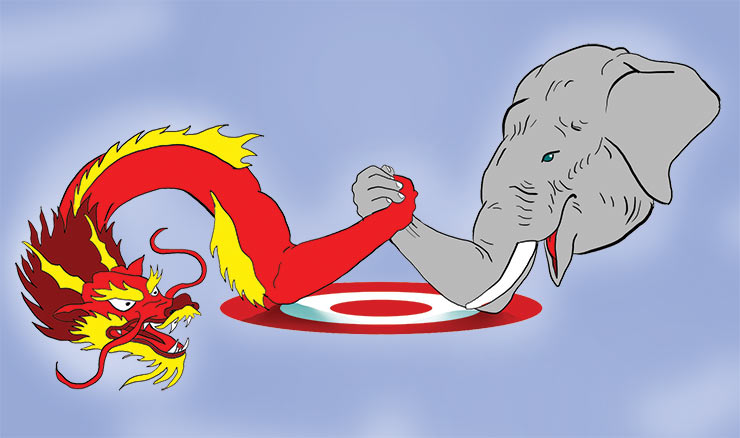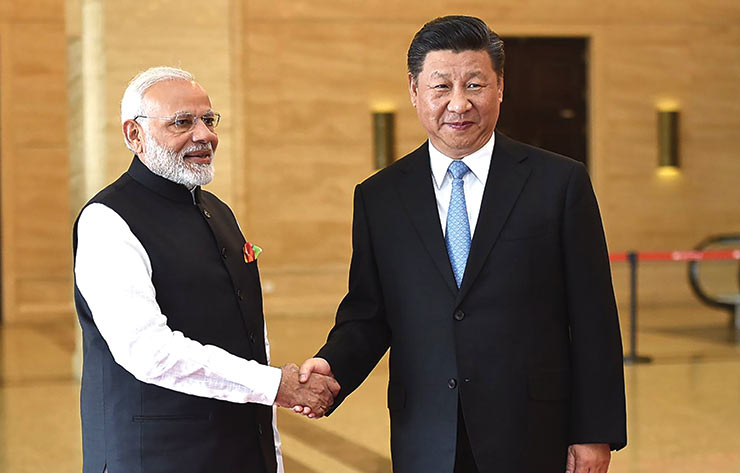
China is at war with us. This statement may shock some because the general hierarchical understanding of war is confined to conventional war. But the character of war turned hybrid long back, which encompasses all forms of warfare. It is undeclared, ambiguous, borderless, perpetually ongoing, and has no rules and regulations. Conventional war is just one part of hybrid war.
Forms of warfare include military capabilities, advanced military technology, insurgencies, terrorism, guerrilla warfare, organised crime, cyber warfare or more precisely political warfare, conventional warfare, cyber warfare, asymmetric and no contact warfare, irregular warfare, information warfare, psychological operations, terror, sabotage, subversion and criminality. Our Armed Forces are undoubtedly battle-hardened compared to the Chinese, but in most of these types of warfare and advanced military technologies, we are behind China.
Wars are not merely between two militaries but between nations, using comprehensive national power (CNP). CNP can be calculated numerically by combining various quantitative indices to create a single number measuring the power of a nation-state. These indices take into account military, political, economic and cultural factors. However, such calculations are nebulous and fluctuating. Hence, there is no global index listing the CNP ratings of individual nations.
Chin-lung Chiang of Taiwan’s National Chin Yi University of Technology (NCUIT) counts critical mass, economic capacity and military capacity as the national strategic resources index; comparable to the human development index (HDI) in understanding and reliability. American academician Michael Eugene Porter lists five significant resources (physical, human, infrastructure, knowledge and capital resources) as national strategic resources divided into eight categories that constitute CNP: economic resources; natural resources; capital resources; knowledge and technology resources; government resources; military resources; international resources, and; cultural resources.
Let us just examine the economies amid cries about China’s faltering economy and its Belt and Road Initiative (BRI) in the doldrums. China’s economy stands today at US$19.37 trillion and 150+ countries/organisations are part of China’s BRI, including 52 from Africa. We boast of a US$5 trillion economy by 2024-2025 although today at a 50-year low in household savings at 5.1 percent and household debt at 37.6 percent of GDP. We write off crores worth of bank loans to corporates in exchange for election funding, hide external debts to influence voters, central money gets diverted to unknown repositories, while money from a welfare scheme like Ujjwala Yojna was found going into a ‘single’ account.
China’s economy stands at US$19.37 trillion and 150+ countries/organisations are part of China’s BRI, including 52 from Africa. We boast of a US$5 trillion economy by 2024-2025, although today at a 50-year low in household savings at 5.1 percent
The government pretends to red-flag China for its 2020 aggression in Ladakh and continuing India-China standoff along the entire LAC but bilateral India-China trade touched an all-time high of US$135.98 billion in 2022; in China’s favour at US$101.02 billion for the first time – much more than what it was before the 2020 Chinese aggression. Are we beseeching China to not advance beyond the territory it occupied in 2020?
We don’t have a national security strategy despite the NSA tasked to define one in 2019 and the notion that economics is everything and security at second place prevails. Capital purchases have political overtones to keep global powers on our side and successive defence budgets are negative in actual terms; undermining military modernisation. Crores are spent on electioneering. Rs 990 crore in Union Budget 2023-2024 for India’s G20 Presidency was increased to Rs 18,050 crore but we spent over Rs 4,100 crore.
India failed to name China the aggressor in 2020. We have lost control of 4,067+ sq km territory as per BJP MP Subramanian Swamy. This includes traditional grazing grounds, in addition to vacating the strategic Ladakh range in our own territory. The government denies this, dubs PLA intrusions “friction points” but continues military-to-military talks to divert attention. BJP MP Tapir Gao told Parliament that the Chinese are 50-60 km inside Arunachal Pradesh. All this indicates a lack of political will bordering on cowardice to stand up to China. We have no political will to even penalise Pakistan under the euphemism that India can’t go to war with Pakistan after every terror attack. Is there no other option?

China’s “deep coalitions” can include two or more nation states (Pakistan and Myanmar?), civil society organisations, narcotic mafias, some private corporations, individual speculators and other unknown components. The concept involves players at many levels of the system; multi-dimensional with all groups operating continuously – multiplying, fissioning, fusing into others, and so on. Not only we don’t have an equivalent, but we have “created” a situation in Manipur for China to exploit.
The government pretends to red-flag China for its 2020 aggression in Ladakh but bilateral India-China trade touched an all-time high of US$135.98 billion in 2022, in China’s favour. Are we beseeching China to not advance beyond the territory it occupied in 2020?
China is ahead of us in military modernisation, advanced military technology and in numbers by way of drones, hypersonics, missiles and the like. We have battle-experienced forces but the manpower is undermined by the induction of Agniveers with mere 4-month basic recruit training and restricted 4-year employment, coupled with manpower shortages. We require an effective soldier-machine mix for dealing with adaptive machines and intelligence systems.
The IAF is below the required 42 combat squadrons. HAL has just begun producing the 83 Tejas Mk1A variants to meet the Rs 48,000-crore IAF order, with deliveries of the first aircraft scheduled in February 2024. An additional assembly line for LCA in HAL implies producing 16 aircraft annually. This means five years to supply 83 jets. Additional 100 Mk1A Tejas for the IAF implies a minimum of another six years of production. Yet, we want to export Tejas despite IAF’s deficiencies. Moreover, in what timeframe do we expect HAL to “manufacture” 12 x Su-30 Mk1 fighters given the time taken to develop the Tejas?
The Navy plans to add about 60+ ships in the next 10-12 years, which comes to about five ships being built in one year. How are we going to increase production capacity and are we losing the battle of capital procurement with budget allocations remaining the same? China’s Navy is larger than the US Navy in numbers and its potency has gone up with hypersonic platforms. China is building 15 ships annually and its submarine and underwater capability is much more than ours. Presently some 57 Chinese vessels are in the Indian Ocean. China is not just sending a ‘research’ ship here but making a geopolitical point. Visitation of Chinese surveillance vessels to Sri Lanka is becoming the new normal, signaling the deployment of the PLA Navy.
After Justin Trudeau accused India of involvement in the killing of Khalistani Hardeep Singh Nijjar, India downsized the Canadian embassy and also suspended visas. But India didn’t even issue a demarche to China for its 2020 aggression and hasn’t responded to the absence of any Chinese ambassador to India for over a year
Chinese are past masters in strategic, operational and tactical deception. Chinese define strategic deception as luring opponents into developing misperceptions to obtain a strategic advantage by producing multiple false phenomena in an organised manner. The two main drivers of China’s strategic deception are enhanced information warfare and asymmetric warfare capability. China plans the completion of its G-695 expressway running close to Galwan and Hot Springs by 2035. However, China may initiate the next conflict much earlier.
After Justin Trudeau accused India of involvement in the killing of Khalistani Hardeep Singh Nijjar, India downsized the Canadian embassy and also suspended visas. But India didn’t even issue a demarche to China for its 2020 aggression and hasn’t responded to the absence of any Chinese ambassador to India for over a year.
Finally, readiness is a comparative term that has many levels. The military will always deliver to the best of their capabilities within constraints of lack of (or stuttering) political will at a particular time (s). But it is high time the national hierarchy becomes serious about national security, quits empty rhetoric, and secures the right mix between economy and security.
–The writer is an Indian Army veteran. Views expressed are personal. The views expressed are of the writer and do not necessarily reflect the views of Raksha Anirveda








